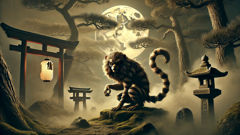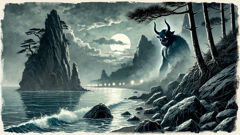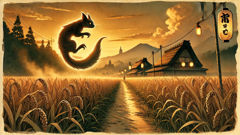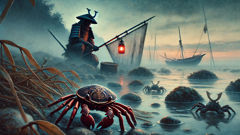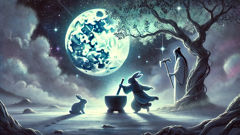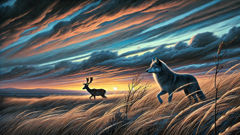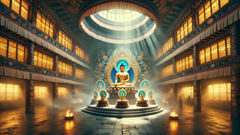Introduction
The Nue arrives in the mind like a breath across a paper lantern: sudden, cold, and carrying the faint scent of pine resin and old smoke. In whispered court records and roadside tales it takes form as a chimera stitched from things that should not belong together: the clever, human-like face of a monkey; the rotund, deceptive torso of a tanuki; the sinewy, striped haunches of a tiger; and a tail that is cold and alive like a coiling serpent. To hear its name is to accept a contradiction—beauty tied to terror, the familiar mixed with the uncanny. In medieval Japan its shadow fell across palace corridors and fishing hamlets alike. Emperors dreamed of wrongness in the night and woke with bodies heavy as if some weight had settled on their chests; fishermen returned from sea with eyes swollen by fever; wives lit lamps and murmured prayers while children clung to their kimonos. The Nue’s legend was not merely a story of a monster but an emblem for a world where dreams and illness, political anxiety and the restlessness of nature, braided themselves into one another.
This account moves through scent and sound and through the scrolls and stones that remembered the creature. It follows the soft, deliberate footfalls through moss and pine needles and through the creaking of lacquered screens in quiet chambers, through the arrow-thin line of moonlight that picks out a snake’s skin, through the small, human detail of a samurai’s breath before he lets an arrow fly. The intention is not only to tell how the Nue was slain or described, but to draw the monster into human terms: images that can be held, names that can be spoken, and meanings that can be traced. Along the way the Nue loosens its hold on simple horror and becomes a mirror: of human fear, of seasonal change, and of how communities have always tried to make sense of the night.
Origins, Sightings, and the Anatomy of Fear
The earliest threads of the Nue’s story are woven into the fabric of court life and rural superstition. Scholarly scrolls from the Heian and later periods mention a creature whose name was uttered alongside unexplained illness and ill omen. Its anatomy—so specific and so outlandish—seems at once a catalog and a cipher. A monkey's head implies cunning mimicry and unexpected intelligence; a tanuki's belly suggests trickery and transformation; tiger legs bring to mind predatory strength and sudden fury; and the snake tail speaks to cold-blooded stealth and venomous finality. Put together, these parts create a being that resists any neat human category. It is not simply predatory or tricksterish; it exists at a threshold where ordinary encounters with animals transition into something symbolic, unsettling, and morally ambiguous.
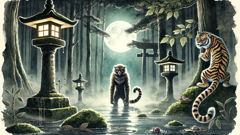
Courtly accounts often fixate less on the monster’s physicality than on its effects. The Nue, legend insists, brings wrongness: fevered nights for rulers, children’s play turned to silent staring, the slow fading of a household’s luck. When the palace fell quiet in a way that made attendants exchange glances—when incense burned low and courtiers dreamed of hearsay beasts—people spoke of the Nue as a cause and a symptom. The medieval mind read the monster as a punctuation mark at the end of a string of anxieties: political shifts, succession fears, and the ever-present threat of contagion. In the imagery used to describe the creature there is an economy of metaphor: each animal part holds a cultural set of associations, and their combination produces a new lexicon of dread. To call someone “like a tanuki” or “like a tiger” played differently than invoking the Nue, whose very name collapsed separate meanings into a single, ominous presence.
Stories of sightings traveled by river and ridge. A night watchman in a fishing village might tell of a creature seen at the edge of waves, its snake tail leaving a slick, serpentine trail along the sand. In mountain hamlets, elders described hearing a sound like a baby wailing that would not be soothed by any cradle-song. Travelers recorded glimpses of the beast slipping across a torii gate, indistinguishable in silhouette from a bundle of rags until it shifted and revealed a face too human and yet not. There are consistent motifs across accounts—moonlight, the smell of damp earth, a sudden hush in domestic spaces—that suggest a shared human choreography of fear. The Nue’s appearances are almost always nocturnal, occurring where the boundary between cultivated space and wildness thins: temple grounds with their moss and stone lanterns, gardens with their hidden ponds, and the thin stretch of trees that protect a village from wind. The night, in Japanese folklore, is not merely dark but morally porous; the Nue exploits that porosity.
Perhaps the most famous iteration of the Nue myth is its connection to the imperial court and the samurai who answered the call to free it from the palace’s shadow. The tale, often retold in dramatic recounting, says that a string of misfortunes afflicted the Emperor—strange noises overhead, misgivings that could not be traced, and a malaise that resisted medicine and prayer alike. An arrow, launched by a named warrior whose steadiness was celebrated across provinces, supposedly struck the Nue as it drifted away into the deep pines. The beast fell, and with its fall the immediate symptoms eased. In that decisive act—archery intersecting myth—there is a narrative resolution that medieval audiences found both comforting and morally instructive: bravery and skill could still cut through uncanny disorder. Yet the image of the monster’s throat pierced by an arrow also leaves the modern reader with a lingering image of a being that may have been part animal and part omen, perhaps even a fragile conglomeration of cultural fear, finally undone by the human capacity to act.
Beyond the spectacle of slaying, the Nue’s anatomy invites deeper metaphorical readings. The tanuki’s body is not only tricksterish; in folk imagination it denotes fertility, unsettled luck, and an awkward humor. The monkey’s face suggests imitation and mimicry of human expression—an unsettling mirror. Tigers, while not native to Japan in the same way as other animals, carry pan-Asian connotations of regal menace and the capacity to rend. The snake’s tail, in many cultures including Japan, is the locus of hidden danger and slow, inexorable poison. Together they form a composite that represents not merely fear of wild creatures but fear of the unexpected convergence of social, environmental, and bodily ailments. The Nue is the night’s answer to the question: what do we become when we cannot distinguish between the inner sickness of a ruler and the outer sickness of the land? What does culture do with that uncertainty but personify it as a monster?
The myth’s persistence is owed partly to its elasticity. Storytellers could amplify the Nue to serve different ends—social critique, moral lesson, or simply the delicious thrill of a spine-tingling tale by fireside. When communities faced plagues, failing harvests, or the unknown consequences of political rivalry, the Nue could be invoked as a figure that made palpable the intangible forces pressing on daily life. By naming the terror, people found ways to ritualize responses: offerings at shrines, the reading of sutras, the lighting of lanterns in patterns intended to guide spirits away. Such practices were not merely superstitious but formed part of a cultural toolkit for resilience. The Nue’s role as both omen and object of ritual thus helped consolidate communal bonds and rituals of care.
Even the language used to describe the creature maps a landscape of fear. The Japanese lexicon surrounding monstrous beings is rich with verbs and adjectives that denote slipping, seeping, and invasion—words that easily apply both to an animal intruding on domestic space and to an illness that quietly takes hold. The Nue becomes a bridge between the material and the metaphorical; its bulging, stitched-together anatomy allows storytellers to point at specific fears and fold them into a single emblem. The result is a myth that endures because it is not fixed; it moves and changes in the telling, like a shadow drifting along the temple wall.
To approach the Nue in full, then, is to attend to both its concrete and abstract parts. It is to note how the smell of damp stone and the pattern of moonlight on lacquered wood have been described alongside courtly anxieties over succession and health. It is to recognize the way communities harnessed ritual and narrative to make sense of the unpredictable. But it is also to sit with the older, human feeling that the world sometimes yields an explanation that is wrong and yet true in another register—a chimera whose assembled body names the variety of what frightens us. In that doubleness lies the Nue’s enduring power: it is at once the monster we fear and the language we use to make fear legible.
From Shrine Offerings to Modern Metaphor: The Nue's Cultural Afterlife
As centuries passed, the Nue did not remain confined to the narrow corridors of court tales. It seeped into the broader cultural imagination, finding homes in woodblock prints, Noh theater, and later popular literature. Each medium reframed the creature, emphasizing different features depending on the social anxieties of its time. In Noh, the figure of the uncanny often takes on a mournful quality; the monstrously altered human or animal voice is given a plaintive song that asks for recognition and perhaps forgiveness. In those performances, the Nue sometimes reads as a symptom of human error or broken taboos—a being that stands for the consequences of social misalignment.
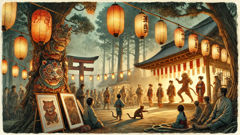
The village shrines and household altars that once offered rice and sake to appease wandering spirits became small museums of local history where the tale of the Nue might be told in the same breath as harvest legends and ancestral feats. Folk painters and storytellers adapted the image to teach children about the edges of acceptable behavior: do not wander alone at night, respect the boundaries between cultivated land and the forest, and attend to the health of elders, for their ailments may be connected to larger things. In this way the Nue evolved from a frightening apparition into a pedagogical figure, though one that never lost its edge. Even as it softened in some tellings, the core image—a face too like ours attached to animal parts that do not fit—remained uncanny enough to keep listeners attentive.
In the modern era, the Nue has been reclaimed and reinterpreted through many lenses. Folklorists study it as a lens onto medieval anxieties and ritual practice; ecocritics read it as an emblem of nature's uneasy reply to human imposition and environmental change. Where earlier tellings might have presented the beast simply as a moral or medical explanation, contemporary readings are more willing to look at the Nue as a boundary creature—one that marks the places where human culture and ecological systems meet, sometimes uneasily. The tanuki’s presence in the chimera can be reframed as a reminder of adaptive animal intelligence; the monkey's face can speak to mimicry and the thin line between civil and wild behavior; the tiger legs might be read as the reminder that potent forces sometimes come from afar; the snake tail can be interpreted as representing slow, environmental processes—poisonous runoff, creeping decline—that were not understood in medieval terms but whose effects people felt and mythologized.
Artists and writers in the twentieth and twenty-first centuries have continued to use the Nue as a potent symbol. Graphic novels and contemporary retellings cast it sometimes as a tragic figure, sometimes as a villain, and sometimes as something more ambiguous—an animal-person trapped between eras, a being whose existence forces a reconsideration of the categories we rely on. Museums and cultural festivals in Japan occasionally stage reenactments or feature the chimera in exhibitions about yokai, inviting visitors to engage with the story not simply as a horror but as a cultural artifact. There is also a tendency in modern storytelling to emphasize the psychological and environmental readings: the Nue as embodiment of anxiety, the Nue as ecological alarm bell.
One striking angle is how the Nue helps communities manage grief and anxiety. In pre-modern times, narrativizing a disease or bad fortune as the action of a monster allowed for communal responses: offerings, chants, rites, and the performance of courage. Today, individuals might approach the legend differently, but the impulse remains. When unexpected illness or sudden weather patterns upset a town, people still gather, tell stories, and light candles; the social ritual remains. The Nue, then, continues to function as a narrative tool for making sense of suffering and for channeling actions that knit communities together.
Personal stories thread through the broader cultural picture. Imagine a family living at the edge of a cedar wood, their son recently returned from Kyoto with a cough that would not leave. They lay his futon close to the hearth, keep a bowl of rice and a cup of water near the threshold, and whisper the old names that are supposed to keep wandering spirits off. Or picture a retired teacher in a coastal village describing to schoolchildren the time her grandmother said the moon 'looked wrong' and the hens stopped laying for three weeks—signs, she said, of the Nue having passed by. These lived responses are the small, human traces that sustain the legend, the ways it continues to be meaningful.
Folklore scholars note the Nue’s ability to adapt to modern media without losing its essential properties. In film and animation the visual challenge of representing a chimera that is both repulsive and mournful is used to create tension and empathy. Animators play with texture: glossy snake scales, the warm fur of a tanuki, the puckered brow of an almost-human face. Such details matter because they preserve the paradox at the heart of the Nue—one cannot look away and yet one cannot mistake it for simply animal. In academic articles, writers dwell on what the chimera says about the limits of human categorization. In community festivals, people laugh and tell exaggerated stories, keeping the legend alive through ridicule and affection alike.
Perhaps what makes the Nue so durable is its capacity to resist simple moralization. It is not always evil in the straightforward sense; it is, more often, a symptom and a signal. Its presence in stories opens a space where ancient people could talk about things they could not otherwise name: a palace's strange malaise, a village's changing fortune, the slow erosion of a shoreline. Modern readers can take that same image and use it to reflect on ecological change, administrative neglect, or the unraveling of social care. The Nue invites interpretation rather than dictating it. It remains a resonant creature precisely because it is flexible: at times monstrous, at times pitiable, at times merely inscrutable.
In the end, the Nue’s cultural afterlife highlights a central truth about myth: living stories endure because they answer new questions. As Japan confronted new political orders, natural disasters, and cultural shifts, the Nue shifted too—sometimes appearing as a reminder of disciplinary boundaries in social life, sometimes as a cautionary tale about the dangers of ignoring the land. Its composite body continues to be a source of fascination because it reflects how humans assemble meaning—by combining familiar parts into new figures capable of holding complex, often contradictory feelings. The Nue asks us to look carefully at the seams of our own stories and to notice what crawls out from the spaces we leave unexplained.
Conclusion
The Nue persists because it names the many ways the world can go wrong at once. Its assembled body—monkey face, tanuki belly, tiger legs, and snake tail—captures a logic of fear that medieval people recognized when emperors fell ill and fishermen returned with hollowed eyes. Yet the chimera is not merely a relic of superstition. Through ritual, story, and art it has become a cultural tool: a way to shape communal responses, instruct the young, and make sense of ecological and social anxieties. Modern interpretations continue to draw new meaning from the old figure, using the Nue to reflect on environmental change, psychological complexity, and the spaces where human systems collide with the wild. To tell the Nue’s story is to look closely at how people have always crafted narratives to negotiate the unknown. In the hush that follows the tale—when lantern flame trembles and pine needles whisper—the monster remains, less as enemy than as mirror: something assembled from parts of our world that reminds us to be attentive, to ritualize care, and to keep listening to the signs the night offers. The Nue does not only frighten; it teaches a mode of attention that has kept communities alive across seasons and centuries.

